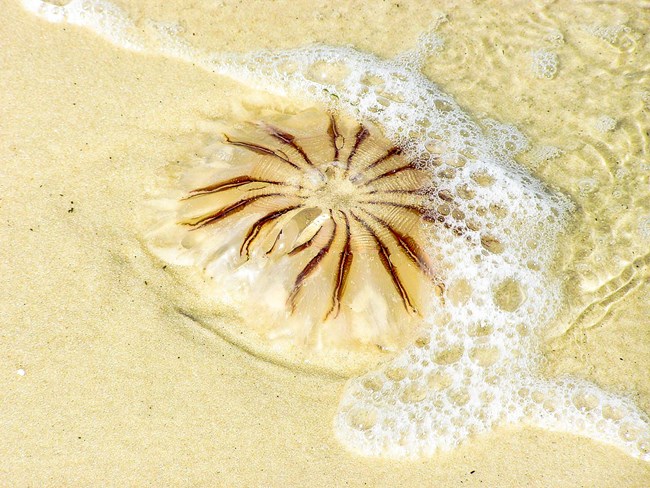
IdentificationJellyfish and siphonophores, are commonly lumped together due to their similar appearance and because they both have soft delicate bodies and tentacles, but that is where their similarities end. Jellyfish are single organisms that are free swimming and capable of moving themselves through water. Siphonophores are a colony of single celled organisms and are ocean drifters, incapable of moving through the water on their own. The single celled organisms that make up these colonies are so dependent on one another that most can’t survive alone. SafetyIf stung by jellyfish or Portugese man-of-war in the water, get out and remove the tentacles using tweezers. Do not use fingers or scrape the tentacles off with a credit card because this can cause further stings (Mayo Clinic 2018). Vinegar should only be used to deactivate stinging cells if you are positive you were not stung by a Portuguese man-of-war. Studies conducted by the University of Georgia’s Skidaway Institute of Oceanography suggest using vinegar on a man-of-war sting can actually make the situation worse. Vinegar can cause unfired stinging cells, called nematocysts, to fire, injecting more venom (Slaughter, R.J. et al 2009). Following removal of any remaining tentacles, apply heat, as warm as the person can tolerate. Pain from stings usually subsides after a few hours, but one should seek immediate medical attention if they experience any signs of allergic reaction. Stay away from jellyfish washed up on the shore because some can still sting days after washed up. Mayo Clinic. (2016) Jellyfish Stings. Electronic document, https://www.mayoclinic.org/diseases-conditions/jellyfish-stings/diagnosis-treatment/drc-20353290 Moneray Bay Aquarium Foundation. (2018) https://www.montereybayaquarium.org/animal-guide/invertebrates/giant-siphonophore Beasley, D.M., Lambie, B.S., Schep, L.J., Slaughter, R.J. (2009) New Zealand’s Venomous Creatures. New Zealand Medical Journal 122, (1290):83-97. Juliana Bardi; Antonio C. Marques. (2007)Taxonomic redescription of the Portuguese man-of-war, Physalia physalis (Cnidaria, Hydrozoa, Siphonophorae, Cystonectae) from Brazil. Iheringia, Sér. Zool. 97(4):426-437. Witherington, Blair, Witherington, Dawn. (2007)Florida's Living Beaches: A Guide for the Curious Beachcomber. Pineapple Press Inc. Sarasota, Fl. |
Last updated: December 9, 2019
